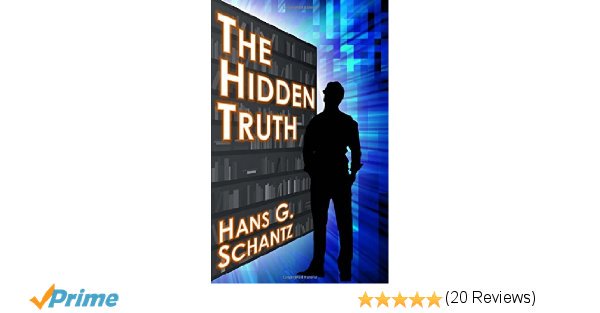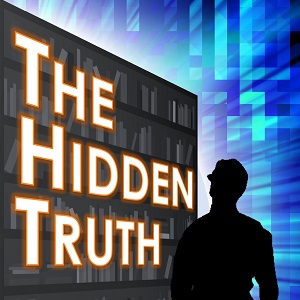 My forthcoming novel, The Hidden Truth is the kind of science fiction techno-thriller I’ve long wanted to read, but haven’t been able to find. This first installment opens with the narrator in high school, struggling to solve a century-old mystery regarding what appears at first to be a minor discrepancy in an old book. Later volumes will follow his career and character development through college, and into an entrepreneurial career of scientific discovery. I will serialize The Hidden Truth here on my blog starting Wednesday, April 6.
My forthcoming novel, The Hidden Truth is the kind of science fiction techno-thriller I’ve long wanted to read, but haven’t been able to find. This first installment opens with the narrator in high school, struggling to solve a century-old mystery regarding what appears at first to be a minor discrepancy in an old book. Later volumes will follow his career and character development through college, and into an entrepreneurial career of scientific discovery. I will serialize The Hidden Truth here on my blog starting Wednesday, April 6.
In addition to the growth and evolution of a hero’s character, I am interested in a realistic portrayal of the growth and evolution of a scientific discovery, through engineering implementation, and into practical applications. Too many science fiction authors gloss over the difficulties and details with a “then, a miracle happens” step, and off to the moon or Mars! Not that works like Heinlein’s Rocketship Galileo or Varley’s Red Thunder aren’t good stories – they are – but for me, the journey to the fascinating scientific or technological discovery is as filled with excitement and drama as the actual breakthrough – its application and implications. Also, I don’t care for portrayals of unrealistically talented heroes. Success follows from hard work, skillfully applied, far more often than it leaps full born from the skull of a super-genius, and luck is when opportunity meets preparation. I’ve tried in my story-telling to show how success really does follow Edison’s recipe of 1% inspiration and 99% perspiration.
Other very talented writers have tackled creating fictional worlds in which their young characters begin a career, then grow and evolve into heroic stature. The classic of this genre is probably C.S. Forrester’s Horatio Hornblower series, following the titular hero from his beginnings as a midshipman, through his service as captain of a “ship of the line” in the Napoleonic wars, to his final adventure as a retired admiral. David Weber’s Honor Harrington series (start with On Basilisk Station), Lois Bujold’s Miles Vorkosigan Saga (The Warrior’s Apprentice is a good place to start), and Peter Grant’s Maxwell saga are all excellent examples of this kind of story-telling. A good series of this genre starts with a young and naive hero who through strength of character and hard work gradually acquires the experience and skills that lead to ultimate success.
There are many fine science fiction writers who write outstanding military science fiction that depicts combat and conflict in a futuristic, yet credible, way. Unfortunately, there’s not much science fiction written from the perspective of an entrepreneur or businessman. Writing is a notoriously poorly paid line of work, and a truly successful entrepreneur, inventor, or businessman is unlikely to make as much from writing as from a successful start-up. Further, the demands of entrepreneurship and family responsibilities leave little time for writing. Still, there are a few science fiction works I’ve come across that do touch on the inherent drama and excitement of business and technical entrepreneurship.
Heinlein’s Citizen of the Galaxy has its moments, portraying the business dealings of interstellar Free Traders and the inner machinations of a large corporation. Leo Frankowski did an excellent job working realistic cash flow issues in a dramatic and engaging way in The Fata Morgana, but it was all just background to launch him into his “real” story, which I didn’t find as compelling. More recently, Vin Suprynowicz has begun a series of books involving book collector heroes who find and solve science fiction mysteries involving rare books and old documents: The Testament of James and The Miskatonic Manuscript are his first two installments. Drawing on his own experience as a collector and dealer of used books, Suprynowicz does an excellent job of depicting the challenges his heroes face in distinguishing book club editions from more valuable printings and managing to make a living in a difficult business.
As an entrepreneur, I sense a market opportunity for a series that follows a young hero through his undergraduate days and off into a career of scientific discovery and entrepreneurship. I want to portray the challenges, the hard work, the discoveries, the incremental steps, the set backs, the breakthroughs, the initial clumsy implementations, the prototypes, and the revolutionary product that changes the world. I believe I can make an interesting story of it, drawing on my own experience base.
Combining a variety of diverse story elements, The Hidden Truth is an alternate timeline, science-fiction techno-thriller. I enjoy a good mystery as well, one which draws on a wealth of historical fact in a realistic setting. Some of my favorite stories, like Jim Butcher’s Dresden Files (Book 1: Storm Front) or Larry Correia’s Grimnoir Chronicles take place in alternate worlds very much like our own. Butcher’s hero, Larry Dresden, is a modern-day wizard/private investigator who keeps the streets of Chicago safe from any number of supernatural threats largely unseen by the city’s more mundane inhabitants. I like Butcher’s depiction of mystery and adventure and epic battles against the supernatural lurking unseen all around us. Correia’s Grimnoir Chronicles work from the assumption that magic began slowly popping up in a small number of talented individuals since the mid-nineteenth century. Set in an alternate 1930s, Correia draws heavily on an extensive knowledge of history, science, and culture to craft an alternate world with enough parallels to our own to keep a reader oriented and enough marvelously creative twists to entertain and thrill. As a novice fiction writer, I believe it will be easier to craft a story in a universe very much – but not quite – like our own, so in The Hidden Truth, I have endeavored to follow the fine example of these gentlemen.
At the same time, I also enjoy historical and technical mysteries: something like Dan Brown’s DaVinci Code or Angels and Demons, but with more plausible history and more credible science. Another book somewhat similar in spirit to The Hidden Truth is Arturo Perez-Reverte’s The Club Dumas, a literary thriller that pays homage to Dumas’s The Three Musketeers. The scientific conspiracy depicted in The Hidden Truth draws on the real-life drama of the discovery of electromagnetics. Winners write the textbooks in science as well as history, and too often we forget that there are multiple plausible models of physical phenomena. The Hidden Truth explores how and why a more correct physical model might have been shunted aside as a deliberate attempt to cripple progress in science and technology.
I’ve had fun rereading dusty old books and finding actual (if subtle) flaws that might be clues to the workings of my conspiracy. You’ll begin to see these revealed starting in the second chapter. The first chapter introduces the hero and his parents and describes the alternate timeline in which the story is set. Check back Wednesday April 6 for Chapter 1 of The Hidden Truth.
Updated 4/24/2016 to add The Club Dumas.



